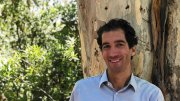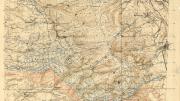Daniel Mason ’98 got his idea for his 2023 novel North Woods while walking in a frozen forest, wondering what his dog was sniffing. During a yearlong retreat to Western Massachusetts, he’d wandered the woods, visually researching his book. At first, he paid close attention to the flora and fauna. But everything changed during one of the first snows when his puppy, Figaro, darted off to chase an interesting smell. Mason saw he was following animal tracks. The creature was long gone, but Figaro still felt its presence. “When a dog is in a forest,” he says, “the dog is not just experiencing it in the moment, but they’re experiencing the history of the forest.”
North Woods, Mason’s fourth novel, is ostensibly about a yellow house and its occupants across three centuries of American history. But it’s really about the process of succession, both human and natural. Like his dog, Mason simultaneously observes the forest’s past and present. A practicing psychiatrist at Stanford University as well as a Pulitzer finalist, he balances two careers that are more alike than one would think.
Mason grew up in Palo Alto, the child of a painter (his mother) and a radiologist (his father). He remembers writing little stories and illustrating them. As a teenager, he’d accompany his father to work and watch surgeries. A scalpel given to him on one of those trips sat on his desk throughout high school, a beacon of his future medical career.
At Harvard, he took pre-med classes, flirted with the social sciences (especially government and economics), and studied writing. Mason settled on biology as a concentration and grew fascinated by plant life. He’d always enjoyed the outdoors—cycling and hiking—but that “experience of it was an experience in it as a kind of adventuring,” he says. A class on the diversity of life with Fisher professor of natural history Andrew Knoll taught Mason that nature itself is an adventure. “All of a sudden, I looked at the forest and realized that the trees around me had names,” he says. “I can still remember being on a bus in Cambridge, stopping at a stop sign, looking out, seeing street trees, and realizing that I knew the names….The world became labeled, and a bit more legible.”
That fascination extended to microbes. As an upperclassman, he mathematically modeled the dynamics of malaria parasite populations in humans. Imagining a medical career focusing on infectious diseases, he spent a year in Bangkok on a Luce Fellowship, researching malaria along the Thailand-Burma border.
When he returned and started medical school at the University of California, San Francisco, he had not written creatively in a year. A short story he produced for a fiction class had received a rejection letter from the Atlantic Monthly that was personalized but also discouraging (it called his work “theatrical and self-limiting”). He started writing a journal about his year abroad, but his reflection as “a 19-year-old guy who goes to study malaria wasn’t…particularly interesting.”
He remembered hearing stories of Europeans who tried to recreate their home environments in Southeast Asia by bringing china sets, bathtubs, or pianos. Intrigued by the juxtaposition, Mason recast his journal as the fictional travel narrative of a young piano tuner in colonial Burma (now Myanmar). Drafting during stolen hours, Mason processed his own experiences abroad and as a medical student. The book flowed out of him—he had no outline, just the story’s start and end. The Piano Tuner was published in 2007 and people loved it: the novel was translated into 28 languages and adapted into an opera and a play.
Now in the public eye, he struggled with his second book, A Far Country. During a four-year writing process, Mason graduated from medical school and deferred his residency. Then, working on his third book—The Winter Soldier, about a young Austrian medical student during World War I—he became interested in psychiatry.
Mason sees writing and medicine as mutually beneficial. “A lot of the concerns of a psychiatrist are similar to the concerns of a writer,” he said. “You’re trying to create a narrative of a life or…understand somebody’s internal world.” The processes are similar, too. When a resident tells him about a patient, he says, the questions he asks about motivations, intentions, and backgrounds “are almost identical to the questions that my editors will ask me.”
After finishing his residency at Stanford in 2015, Mason alternated between careers—a few months practicing as a clinical inpatient psychiatrist followed by a few months of writing. Then in 2021, he was awarded a Guggenheim Fellowship and moved to Western Massachusetts for a year.
There, he explored. He stared at New England’s composite houses, whose expansions and renovations from different eras seemed to contain so many stories. He walked through the woods, noting the changing seasons, identifying birdsongs, and photographing trees. And he ate an unusual apple: an Ashmead’s Kernel, a 300-year-old breed that looks like a potato and tastes like a pear.
Those wanderings inspired North Woods. Grounded in a composite house in the fictional town of Oakfield, Massachusetts, the novel unfolds in 12 parts—each set in a different historical period and month. For Mason, the structure was both artistic and practical. Writing a chapter each month kept him on pace and allowed him to chronicle what he was seeing.
The 12-section structure displays Mason’s versatility, with every character speaking in a distinct style. Some communicate through lyric poems, others through medical logs, letters, speeches, or true crime radio. The constant, though, is his knack for detail, which reorients the reader through changing seasons and generations.
Mason could not write about the past while just observing the present. Today’s New England forests look quite different than those of the past. So, he consulted the Harvard Forest dioramas to travel back in time. Those models fueled his curiosity about succession—the order of plant regrowth following the destruction of a forest. In the novel, Mason does more than name trees: he imagines the sensation of an apple seed becoming a sapling, a fungal spore flying toward a chestnut grove, and an ash borer luring a mate.








